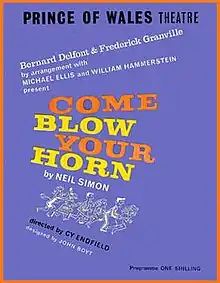| Come Blow Your Horn | |
|---|---|
 Program from West End Production | |
| Written by | Neil Simon |
| Date premiered | February 22, 1961 |
| Place premiered | Brooks Atkinson Theatre Broadway |
| Original language | English |
| Genre | Comedy |
Come Blow Your Horn is Neil Simon's first play, which premiered on Broadway in 1961 and had a London production in 1962 at the Prince of Wales Theatre. Simon rewrote the script more than two dozen times over several years, resulting in a hit premiere that allowed Simon to leave his full-time television writing career to write stage and film scripts.[1]
Productions
Come Blow Your Horn opened on Broadway at the Brooks Atkinson Theatre on February 22, 1961 and closed on October 6, 1962 after 677 performances and one preview.[2] The cast featured Hal March (Alan Baker), Arlene Golonka, Warren Berlinger (Buddy), Lou Jacobi (Mr. Baker) and Pert Kelton (Mrs. Baker). The director was Stanley Prager, with sets and lighting by Ralph Alswang.[3] It was produced by Arthur Cantor.[4]
The play opened in the West End in 1962 at the Prince of Wales Theatre, starring Michael Crawford as Buddy, Bob Monkhouse and David Kossoff.[5][6] The following year the play was the first production to take place at the Wayside Theatre.[7]
The play was revived at the Jewish Repertory Theater, New York City, running in December 1987.[8]
In June 2005, Jacob Murray directed a production at the Royal Exchange, Manchester with Jamie Glover as Alan Baker, Andrew Langtree as Buddy Baker, Malcolm Rennie as Mr Baker and Amanda Boxer as Mrs Baker.
Plot overview
The play tells the story of a young man's decision to leave the home of his parents for the bachelor pad of his older brother who leads a swinging '60s lifestyle. Buddy is a 21-year-old virgin and his older brother Alan is a ladies' man. Alan lives in an apartment in the East Sixties, New York City.
As the play progresses, Alan discovers feelings for one of the many women with whom he is sleeping, and when she leaves him, he falls apart. This juxtaposes Alan's hunger for companionship with Buddy's metamorphosis into a ladies' man. The playwright points out the fundamental spiritual and emotional emptiness of the playboy lifestyle for which the younger sibling desperately yearns.
- Characters
- Alan Baker
- Peggy Evans
- Buddy Baker
- Mr. (Father) Baker
- Connie
- Mrs. (Mother) Baker
Film adaptation
The play was made into a film in 1963, starring Frank Sinatra as Alan and Tony Bill as Buddy.[9]
Inspiration
Simon modeled the on-stage parents on his mother and father.[10]
Reception
Howard Taubman, in his review for The New York Times, wrote that the play was "smoothly plotted and deftly written...Mr. Simon has served up a multitude of sprightly lines. Best of all, he has provided some explosively hilarious moments rooted in character." [11]
References
- ↑ Considine, Basil (3 October 2017). "FEATURE: On Neil Simon's First Play, Come Blow Your Horn". Twin Cities Arts Reader. Retrieved 29 October 2017.
- ↑ Come Blow Your Horn playbillvault.com, accessed April 13, 2012
- ↑ Simon, Neil.Script Come Blow Your Horn (1961), (books.google.com), Samuel French, Inc., ISBN 0-573-60713-3, pp. 1-3
- ↑ Considine, Basil (3 October 2017). "FEATURE: On Neil Simon's First Play, Come Blow Your Horn". Twin Cities Arts Reader. Retrieved 29 October 2017.
- ↑ "Prince of Wales Theatre, History" London Theatre Direct, accessed April 13, 2012
- ↑ "Prince of Wales Theatre, History" london-theatreland.co.uk, accessed April 13, 2012
- ↑ Carmody, James (June 15, 1963). "Art's Council Gets Equity Blessing". Evening Star. pp. B12. Retrieved May 26, 2023.
- ↑ Gussow, Mel (December 31, 1987). "Stage: Early Neil Simon, 'Come Blow Your Horn'". The New York Times.
- ↑ Crowther, Bosley (June 7, 1963). "The Screen: 'Come Blow Your Horn':Sinatra Film Arrives at the Music Hall". The New York Times.
- ↑ Considine, Basil (3 October 2017). "FEATURE: On Neil Simon's First Play, Come Blow Your Horn". Twin Cities Arts Reader. Retrieved 29 October 2017.
- ↑ Taubman, Howard. "Theatre: Lively Comedy: 'Come Blow Your Horn' by Neil Simon Opens", The New York Times, February 23, 1961, p. 31